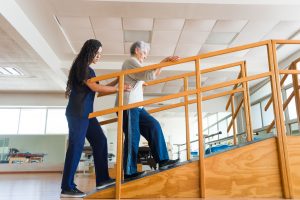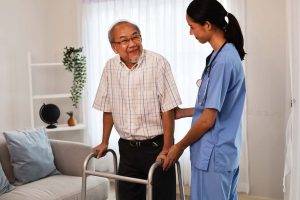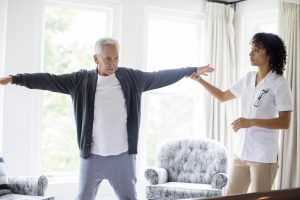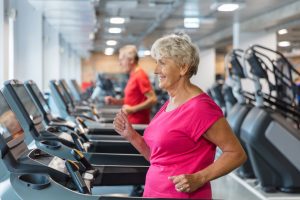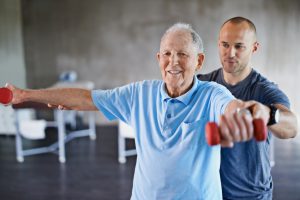
Functional Rehabilitation for Seniors: Fall Prevention, Joint Health, and Longevity
Treatment GuidelinesIt's time to get proactive with our elderly clients' health. Help stop future falls, injuries, loss of mobility and function, and other health problems with this preventive approach to functional rehab.
As our clients age, preventive care becomes more and more important. Functional rehabilitation for seniors can profoundly impact their overall health and wellbeing. With fall-related deaths increasing by 30% in the last decade, we must take a proactive approach with our elderly clients.1 Physical Therapists and Occupational Therapists providing preventive care for seniors will focus on falls prevention, joint health, and promoting longevity through an active lifestyle.
If you work with elderly clients in your rehabilitation clinic, it is important to communicate the benefits of physical activity for injury prevention, mobility, daily functional ability, cardiac health, and overall wellness. In this article, we’ll discuss how functional rehabilitation for seniors can prevent falls, protect joints from injury, and promote longevity. We’ll also review specific preventive care recommendations for your physical therapy or occupational therapy clients. Let’s dive in!
Functional Rehabilitation for Seniors
Preventive care is the best way to lower someone’s fall risk before a fall actually happens, and functional rehabilitation practices are directly translatable to daily tasks. As rehab professionals, it’s our job to skillfully incorporate functional rehabilitation to improve strength, balance, and overall safety for folks at high risk of falls or other injuries.2
Functional rehabilitation is infinitely more than a checklist item after a hip replacement or hospital stay. It has greater meaning than simplex therapeutic exercise protocols because it takes a holistic, personal approach to recovery. As a preventive care plan, functional rehabilitation draws from our daily activities and easily translates to improved functionality.
The importance of functional rehabilitation exercises for seniors cannot be overstated. A sedentary lifestyle leads to poorer health overall. Some conditions that are highly correlated with a sedentary lifestyle and poor physical conditioning status include cardiovascular disease, diabetes, hypertension, arthralgia, and osteoporosis. Physical inactivity itself accounts for 6% of global mortality.3
As an Occupational Therapist, I can attest that the more physically fit someone is, the better their outcomes are when experiencing an illness. Physical activity goes well beyond this notion, however, and can be a strong protective factor against many different health conditions. Incorporating something as small as a group exercise class into a weekly schedule can help create as much as a 41% decrease in fall risk.4
Functional Rehabilitation for Fall Prevention
Fall prevention should be a top priority for all rehab professionals working with seniors. Many clients underestimate their vulnerability to a life-altering fall. Unfortunately, I have treated many seniors with spinal cord injuries and multiple fractures from just one fall.
The reality is, the more risk factors an individual has that contributes to falling, the higher the probability that a fall will happen. Escalation to an exponential degree (up to 78%) can be attributed to someone having only four of the following risk factors:5
- A history of falls
- Polypharmacy (over four medications regularly on board) or taking psychoactive drugs
- Visual problems
- Reduced muscle strength
- Pain
- Over 80 years old
- Incontinence
- Cognitive difficulties
- Diabetes
- Arthritis
- Depression
- Gait difficulty
- Dizziness
Living longer takes more of a toll on the body than most give credit for. Age-related vision changes, sarcopenia, additions of new medications, and other chronic conditions such as Parkinson’s disease or diabetes all affect an individual’s fall risk. Add in the effects of more sedentary lifestyles across all ages, and you start to see a statistical correlation: fall-related deaths have risen 30% over the past decade alone.1
Home Adaptations for Fall Prevention
Home adaptations are equally as useful in a fall prevention plan. The most common areas for falls are bedrooms, bathrooms, and entryways. Getting up in the middle of the night to use the restroom can be precarious in itself, without vision and vestibular balance changes. Good practices to mitigate environmental fall hazards can include:
- Using a nightlight in the bathroom or along the hallways
- Get rid of the throw rugs, or use double-sided carpet tape for larger area rugs
- Make sure extension cords, lamp cords, or electronic equipment cords are not in traffic areas
- Use stud-installed handles in showers and bathrooms (never the suction cup handles)
- Bathmats need to have a nonslip backing
Another aspects I stress to my own patients is gauging one’s endurance while completing tasks. I say, “Leave enough gas in the tank” to get to a safe resting position. When people start to rush, mistakes and falls happen.
Endurance takes time to build up in a functional rehabilitation program and can be hard to work through when changes are incremental at first. Nevertheless, the more endurance someone has, the better they are at being safe throughout the day.
Functional Rehabilitation Helps Clients Live Stronger, Live Safer
Strength and conditioning have been consistent markers of mortality and morbidity historically. It affects the level of flexibility, balance, and overall coordination of the body. When everything in the body works as a cohesive system, imbalance in certain areas can quickly exacerbate and lead to injuries if ignored.6
Interestingly enough, grip strength is a biomarker that correlates with fall risk in older adults.7 Grip strength reflects age-related changes in overall strength, which is a significant indicator of fall risk. Read more about grip strength’s correlation to key health factors: Grip Strength as a Biomarker in Older Adults.
Our clients commonly choose more sedentary activities as they age. Unfortunately, this habit can lead to a loss of functional endurance during everyday activities. This could look like no longer being able to mow the lawn, spend a day on their feet at a museum, or even play with grandchildren.
Functional rehabilitation for seniors can help prevent this decline and possibly even reverse the trend. Building strength and endurance with your elderly clients helps prevent injury, promotes daily functional ability, and boosts their overall health in a huge way. As Physical Therapists and Occupational Therapists, we are in a unique position to help prevent future health problems before they start.
Joint Health and Preventive Care
When we think of joint health, we imagine arthritis, joint replacements, or maybe those glucosamine and chondroitin supplement infomercials. Joint health matters just as much as strength, endurance, and balance. It contributes to flexibility and the overall integrity of tendons, ligaments, and other connective tissues.
Joint health and joint function directly influence range of motion and influence how the body works in tandem with itself. When conditions like arthritis and stenosis start to advance, flexibility decreases, and so does overall movement during the day.
When speaking about joint health, we often overlook spinal joints. All 30 of the vertebral bones have varying degrees of flexion and extension, just like knees and fingers. Spinal stenosis is a top contributor to loss of spinal flexibility and is an important condition to consider in preventive care exercise plans, as it affects 50% of people over 60 years old.8
Functional rehabilitation for seniors should include activities that move through a full range of motion for a joint or the spine. These activities can help increase or at least maintain overall flexibility in daily movements. In fact, flexibility at the neck, lumbar, hips, and ankles, in particular, is essential for reducing the risk of falls and mobility-related injuries. 6,9
When I’m assessing this type of flexibility, I use the Functional Reach Test. The Functional Reach Test is a quick, objective measurement that can justify skilled therapeutic services and track progress. While this test has somewhat low validity in isolation to identify fall risk, usually, that risk has already been assessed.10
Yoga, Tai Chi11, static and dynamic stretching routines, as well as resistance and mobility exercises that focus on larger compound movements like a squat or reaching well outside a base of support, are all beneficial components to build into a rehab routine. We don’t just want a joint to be flexible; we want it to be functional and reliable during daily movements. Being able to bend a hip during an exercise doesn’t do much good unless it translates to getting on and off a toilet, out of a recliner, or up from the kitchen table safely!
The Role of Aerobics
Aerobics are an integral part of a leisure routine and functional rehabilitation approach to preventive care for seniors. Statistically, aerobics improve outcomes for many populations, including those experiencing Parkinson’s, post-stroke, or cardiac conditions.
Low-impact activities that serve a functional role in someone’s life are also a great avenue to pursue. Integrating a new hobby, such as Tai Chi, has even been shown to improve motor symptoms and balance scores in those with upper motor neuron disorders.11
Aerobic activity blends form and function; gross motor skills, flexibility, executive functioning skills, and gleeful engagement in something intrinsically valuable are all valuable in an individual’s routine. Aerobics not only improves cardiovascular health in general but also can help mitigate cardiovascular comorbidities in those with a neurological injury.12
Start Before Falls Happen
Functional rehabilitation often isn’t introduced into anyone’s routine until a fall or injury does happen. The unfortunate reality is that sometimes those stumbles, falls, and injuries can be much more traumatic than a simple bruise or fracture. It could be a life-changing brain or spinal injury, or even death. As rehabilitation professionals, we have the opportunity and duty to help prevent injury and promote wellness for our senior clients.
By employing functional rehabilitation for seniors as preventive care, we can improve the lives of our clients significantly. A functional approach to exercise serves a unique purpose in preventing falls and injuries in older adults. It directly translates to daily life and can revitalize older adults as they improve mobility, coordination, and endurance. This can help our senior clients live healthier, longer lives.
Mary Vieregge, OTR/L is an Occupational Therapist and freelance writer based in Eastern North Carolina. She has experience in a range of settings, from inpatient rehabilitation to long-term care, with a concentration in neurorehabilitation and spinal cord injury populations. Mary is passionate about patient education and innovative practices, is constantly searching for the latest and greatest to add to her clinical toolbox, and enjoys connecting over LinkedIn or UpWork.



